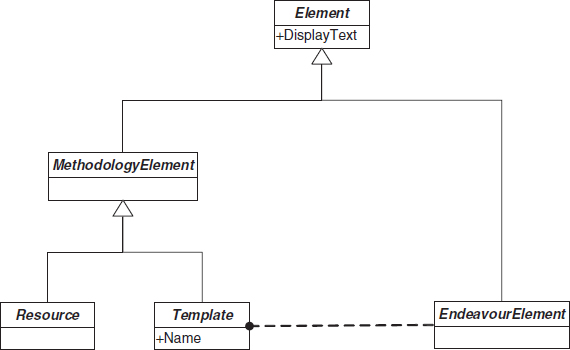6.2 HIGH-LEVEL VIEW
ISO/IEC 24744 reflects the concerns of Section 6.1 and is structured at the topmost level (Figure 6.7) in terms of metaclasses called MethodologyElement and EndeavourElement – we noted in Section 6.1 the aim of supporting both methodology modelling and enactment on endeavours – both of which are subtypes of Element. In fact, there is a powertype pattern relationship between Template and EndeavourElement since Template is the abstract type of all elements in the Method domain that will have instances in the Endeavour domain and EndeavourElement is the abstract superclass of the same elements. In this powertype pattern, EndeavourElement is the partitioned type and Template.Name is the discriminant.
For methodology metamodelling, addressed by the bulk of the classes in this metamodel, there are two major subtypes to MethodologyElement: Template and Resource. Both Template and Resource each have five major subtypes. Figure 6.8 shows the powertype patterns towards the left-hand side of the diagram with a dashed line with a solid dot at the powertype end (there is no UML notation for this classification relationship in a powertype). Since we frequently discuss both classes in the powertype pattern together, we will, in the following discussion, use the abbreviation xxx/*Kind. For example, we use “Task/*Kind” as a shorthand for “Task and TaskKind”.

Figure 6.7: Very ...
Get Metamodelling for Software Engineering now with the O’Reilly learning platform.
O’Reilly members experience books, live events, courses curated by job role, and more from O’Reilly and nearly 200 top publishers.

